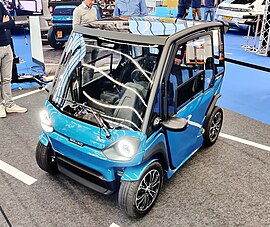
An electric vehicle (EV) is a vehicle that uses one or more electric motors for propulsion. It can be powered by a collector system, with electricity from extravehicular sources, or it can be powered autonomously by a battery. EVs include, but are not limited to, road and rail vehicles, surface and underwater vessels, electric aircraft, and electric spacecraft. For road vehicles, together with other emerging automotive technologies such as autonomous driving, connected vehicles, and shared mobility, EVs form a future mobility vision called Connected, Autonomous, Shared, and Electric (CASE) Mobility.

The Toyota RAV4 EV is an all-electric version of the popular RAV4 SUV produced by Toyota until 2014. Two generations of the EV model were sold in California, and to fleets elsewhere in the US, with a gap of almost ten years between them.
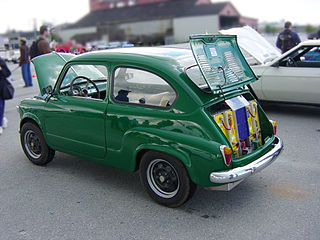
In automobile engineering, electric vehicle conversion is the replacement of a car's combustion engine and connected components with an electric motor and batteries, to create an all-electric vehicle (AEV).
MIEV (Mitsubishi In-wheel motor Electric Vehicle) or MiEV (Mitsubishi innovative Electric Vehicle) is the name given by Japanese automaker Mitsubishi Motors (MMC) to its alternative propulsion technologies. From late 2006, “MiEV” encompasses all of Mitsubishi Motors’s electric drive systems work, including lithium-ion batteries, in-wheel motors and other technologies related to electric vehicle (EV), hybrid-electric vehicle and fuel-cell vehicles.

A charging station, also known as a charge point or electric vehicle supply equipment (EVSE), is a power supply device that supplies electrical power for recharging plug-in electric vehicles.

A solar car is a solar vehicle for use on public roads or race tracks. Solar vehicles are electric vehicles that use self-contained solar cells to provide full or partial power to the vehicle via sunlight. Solar vehicles typically contain a rechargeable battery to help regulate and store the energy from the solar cells and from regenerative braking. Some solar cars can be plugged into external power sources to supplement the power of sunlight used to charge their battery.
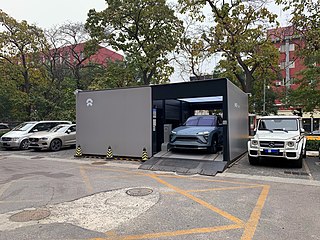
Battery swapping or battery switching is an electric vehicle technology that allows battery electric vehicles to quickly exchange a discharged battery pack for a fully charged new one, as an alternative to recharging the vehicle via a charging station. Battery swapping is common in electric forklift applications.

An electric vehicle battery is a rechargeable battery used to power the electric motors of a battery electric vehicle (BEV) or hybrid electric vehicle (HEV).

An electric car or electric vehicle (EV) is an automobile that is propelled by one or more electric traction motors, using only energy stored in batteries. Compared to conventional internal combustion engine (ICE) vehicles, electric cars are quieter, more responsive, have superior energy conversion efficiency and no exhaust emissions and lower overall vehicle emissions. The term "electric car" normally only specifically refers to battery electric vehicle (BEV), but broadly may also include plug-in hybrid electric vehicle (PHEV), range-extended electric vehicle (REEV) and fuel cell electric vehicle (FCEV).

The Mitsubishi i-MiEV is a five-door hatchback electric car produced in the 2010s by Mitsubishi Motors, and is the electric version of the Mitsubishi i. Rebadged variants of the i-MiEV are also sold by PSA as the Peugeot iOn and Citroën C-Zero, mainly in Europe. The i-MiEV was the world's first modern highway-capable mass production electric car.

The Smart EQ Fortwo, formerly Smart Fortwo electric drive, smart ed or Smart Fortwo EV, is a battery electric vehicle variant of the Smart Fortwo city car made by Smart.

The Nissan Leaf, stylized as LEAF, is a battery-electric powered compact car manufactured by Nissan. It was introduced in Japan and the United States in December 2010, and its second generation was introduced in October 2017. The Leaf's range on a full charge has been increased gradually from 117 km to 364 km, due to the use of a larger battery pack along with several minor improvements.

The Renault Twizy is a two-seat electric microcar designed and marketed by Renault. It is classified in Europe as either a light or heavy quadricycle depending on the output power, which is either 4 kW (5.4 hp) for the 45 model or 13 kW (17 hp) for the 80 model, both names reflecting its top speed in km/h. Originally manufactured in Valladolid, Spain, production was moved to Busan in South Korea in March 2019 to meet increased demand in Asia.

The Kia Soul EV is an all-electric subcompact crossover SUV manufactured by Kia and based on the Kia Soul. The US Environmental Protection Agency (EPA) official range for the 2020 Kia Soul EV is 243 miles (391 km).
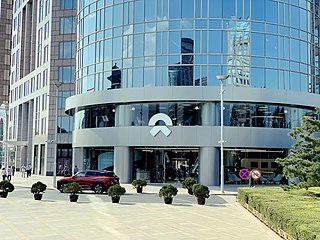
Nio Inc. is a Chinese multinational automobile manufacturer headquartered in Shanghai, specializing in designing and developing electric vehicles. The company develops battery-swapping stations for its vehicles, as an alternative to conventional charging stations. The company has raised over $5 billion from investors. In 2021, Nio plans to expand to 25 different countries and regions by 2025.

The Audi Q8 e-tron is a battery electric mid-size luxury crossover produced by Audi since 2019. The e-tron was unveiled as a concept car at the 2015 Frankfurt Motor Show. The final production version was revealed in San Francisco on 17 September 2018, publicly debuted at the 2018 Paris Motor Show, and was first delivered in May 2019. It is the company's first battery electric mass production car. The Sportback variant, a coupe style of the e-tron, entered production in 2020.
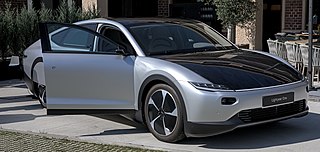
The Lightyear 0 is an all-solar-electric car by Lightyear. Production was originally scheduled to start in 2021, with a starting price of €250,000 incl. VAT. The first units were delivered in December 2022. In January 2023, Lightyear announced that it was halting production of the 0 model, and that Atlas Technologies B.V., the subsidiary responsible for the manufacture of the Lightyear 0, would be allowed to go bankrupt.

The Hyundai Ioniq 5 is a battery electric compact crossover SUV produced by Hyundai since 2021. It is the first product to be marketed under the electric cars-focused Ioniq sub-brand, and the first model developed on the Hyundai Electric Global Modular Platform (E-GMP).

Hyundai E-GMP is a dedicated battery electric vehicle platform for Hyundai Motor Group automobiles. It is the first electric-only dedicated platform by Hyundai. It has been used for Hyundai, Kia, and Genesis automobiles starting in 2021. It follows Hyundai's earlier Power Electric System, which describes the drivetrain of an electric vehicle, including the traction motor, storage battery, and power electronics.
